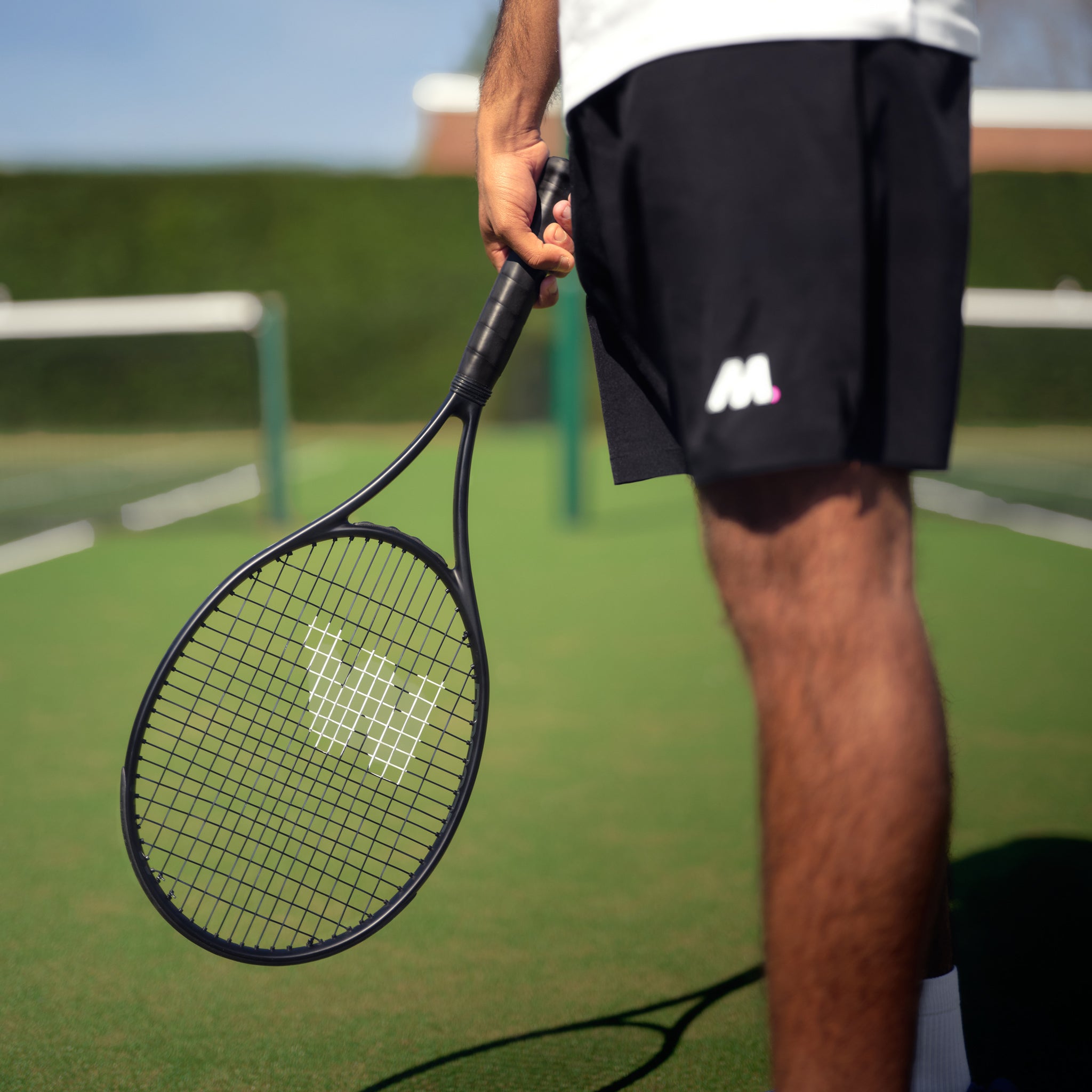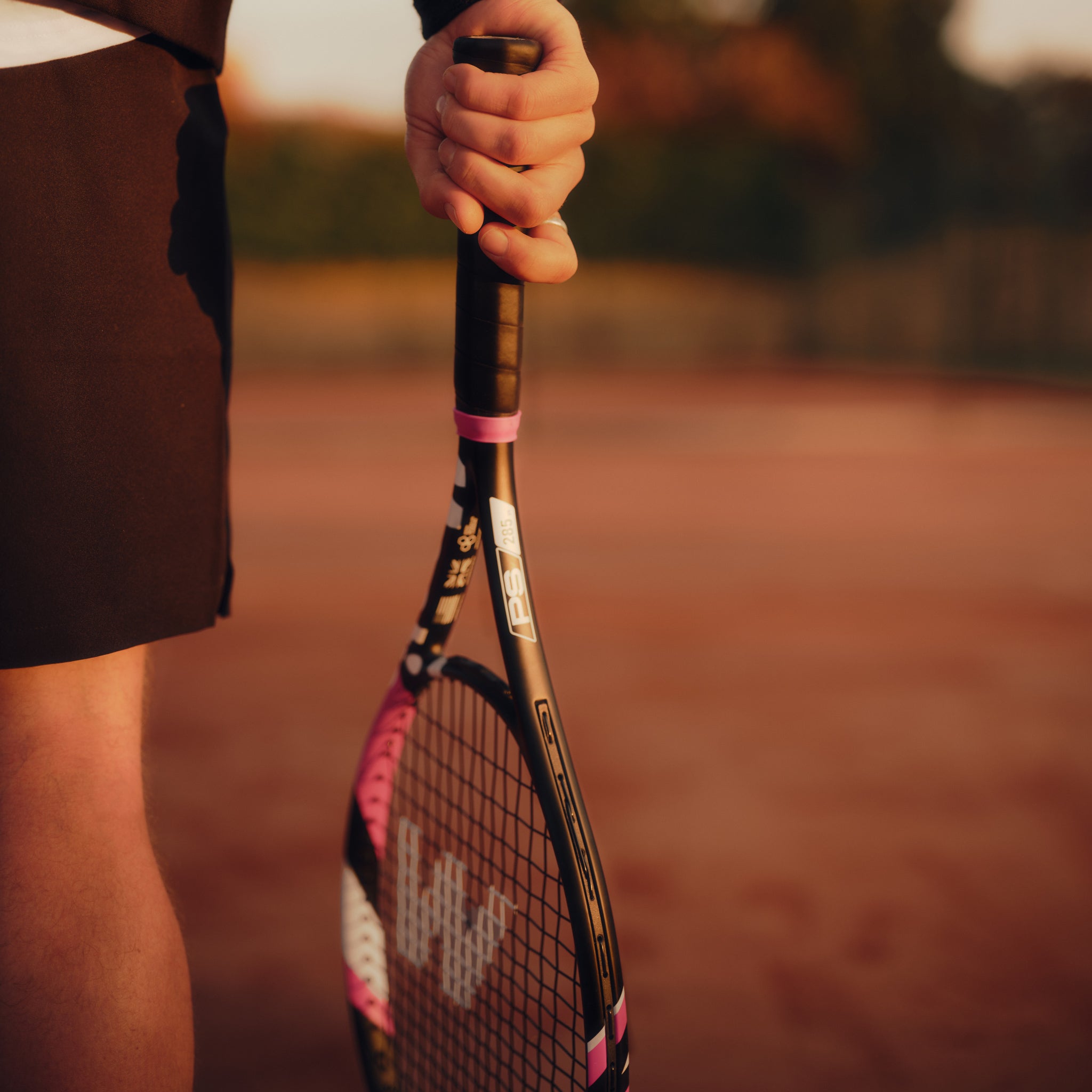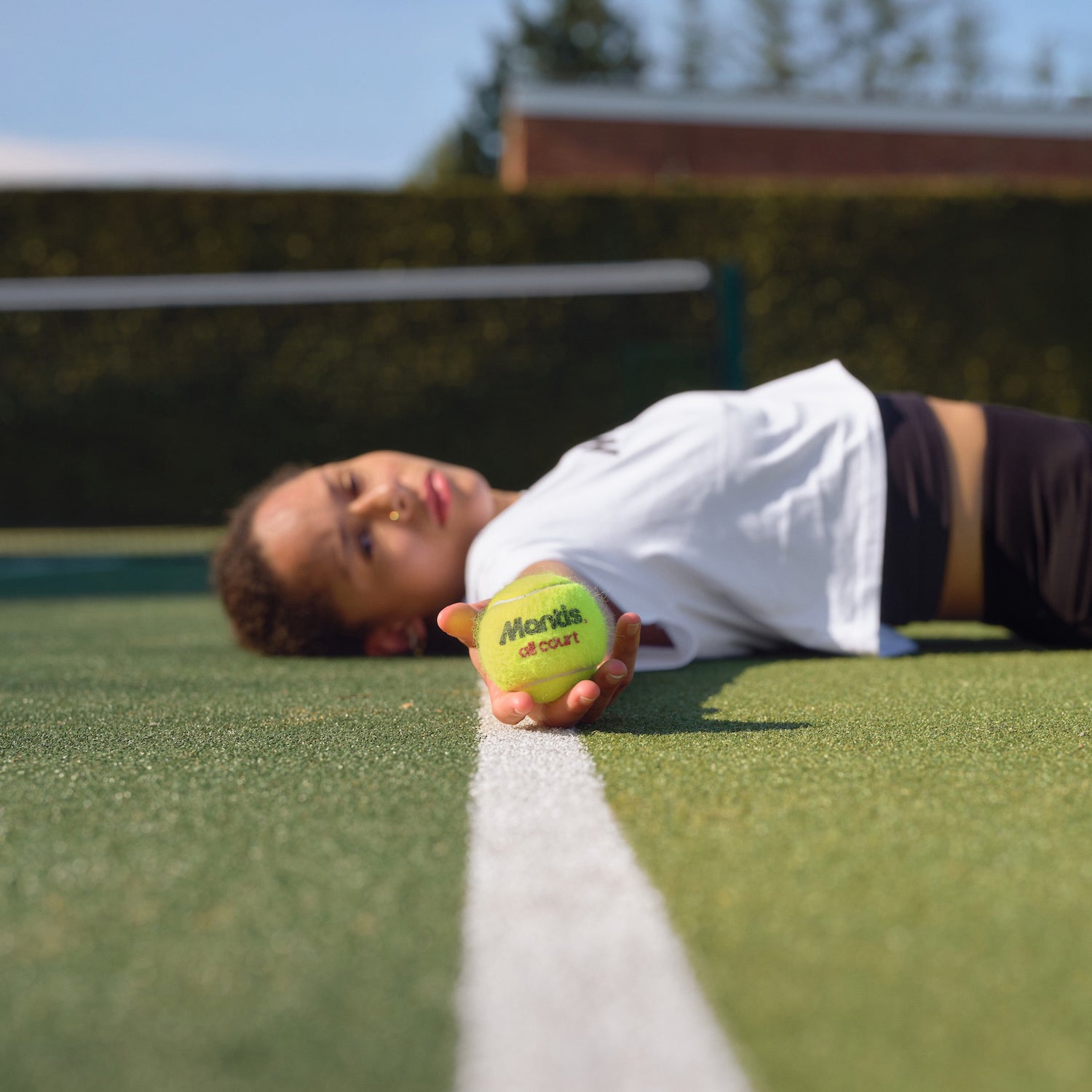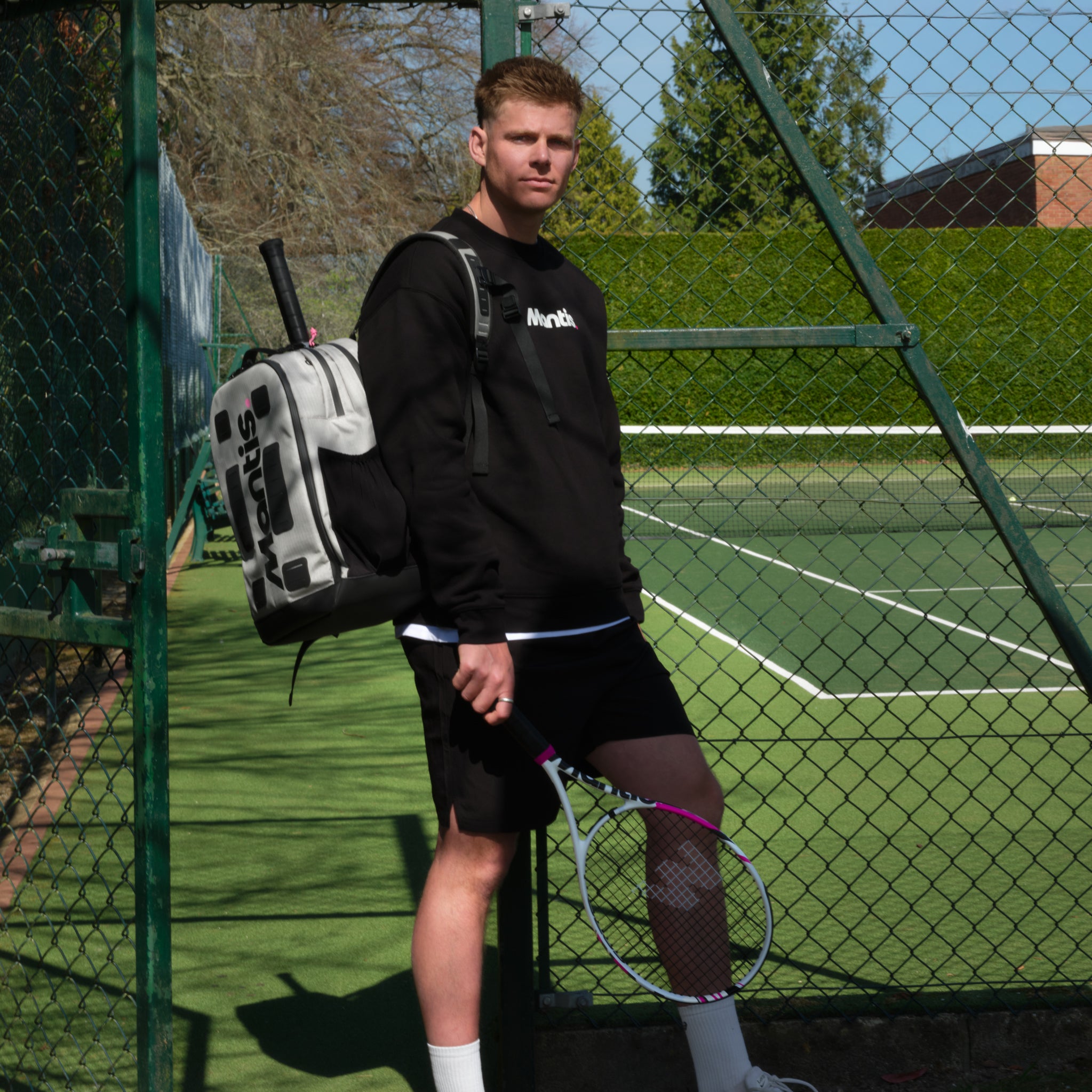
If you’re serious about getting better at tennis, you’ve come to the right place. It’s a journey that’s about much more than just hitting balls; it’s a brilliant blend of physical power, smart tactics, and a good dose of mental grit.
Real, lasting improvement isn't about finding one magic trick. It comes from a structured, intelligent approach that focuses on four key areas: mastering your technique, practising with purpose, boosting your on-court fitness, and building a winner's mindset.
Your Path to getting better at tennis
So, you want to elevate your tennis game. It’s an exciting challenge, and one that millions of players—from weekend warriors to aspiring pros—are on right alongside you. You're not just learning a sport; you're developing a craft that demands dedication, sweat, and a sharp mind.
This guide isn't about vague tips you’ve heard a thousand times. It’s a clear, actionable roadmap designed to deliver real, noticeable progress on the court. We’ll break down the essentials that separate a casual hitter from a truly formidable competitor.
And you're in great company. Tennis is booming across Great Britain right now. In fact, data from the Lawn Tennis Association (LTA) shows that between 2019 and 2023, adult participation jumped by an incredible 44%. That means around 5.6 million adults are now playing, which is roughly 10% of the UK population. The sport has never felt more accessible. You can dig into the details on Britain's growing love for tennis if you're curious.
The Four Pillars of Improvement
The secret to getting better isn’t trying to fix everything at once. That’s a recipe for frustration. Instead, a smarter approach is to organise your efforts around four core pillars. Focusing on these ensures you’re building a complete, well-rounded game.
-
Technique and Fundamentals: This is the bedrock of everything. It’s about fine-tuning the biomechanics of your forehand, backhand, serve, and volleys. The goal is to create effortless power and consistency that holds up under pressure.
-
Purposeful Practice: This means moving beyond just hitting balls mindlessly across the net. It’s about using drills that actually simulate match situations, sharpening your accuracy, footwork, and tactical brain when it counts.
-
Physical Conditioning: Tennis is a game of short, explosive bursts of movement. You need to build sport-specific strength, agility, and endurance so you can play just as hard in the final set as you did in the first game.
-
Mental Fortitude: The battle is so often won and lost in your head. Learning to be resilient, stay focused, and think strategically is every bit as critical as having a massive forehand.
A classic mistake we see players make is obsessing over their weaknesses. Of course, you need to work on them, but don't neglect your strengths. If you have a killer forehand, make it an absolute weapon. Having a reliable "superpower" shot is what will control rallies and win you those crucial points.
To help you keep these areas in focus, let's break them down into a simple framework. Think of these as the foundation upon which you'll build your entire game.
Core Pillars for Tennis Improvement at a Glance
This table summarises the key areas you must focus on to systematically improve your tennis. It’s a quick-reference guide to the concepts we'll be diving into throughout this guide.
| Pillar of Improvement | Primary Focus | Key Outcome |
|---|---|---|
| Technique & Fundamentals | Refining stroke mechanics and consistency. | Effortless power, fewer unforced errors, and reliable shots. |
| Purposeful Practice | Drills that mimic match pressure and scenarios. | Improved accuracy, better decision-making, and tactical awareness. |
| Physical Conditioning | Building sport-specific strength, agility, and stamina. | Sustained high performance, injury prevention, and better court coverage. |
| Mental Fortitude | Developing resilience, focus, and on-court strategy. | Winning tight matches, staying positive, and playing smarter under pressure. |
By consistently dedicating time to each of these pillars, you're not just hoping to get better—you're creating a structured system for success. It’s about building a game that’s not only more powerful but also smarter and more resilient.
Refining Your Core Strokes and Technique
Solid fundamentals are the absolute bedrock of a good tennis game. It's one thing to know how to hit a forehand, but real improvement comes from understanding the biomechanics behind effortless power and pin-point control. This is where we go beyond the basics and dig into the details that separate a decent player from a great one.
Every powerful, fluid shot you see a pro hit starts from the ground up. This concept is called the kinetic chain, and it’s the secret to generating explosive racket head speed without trying to muscle the ball over the net. It’s all about transferring energy efficiently—from your legs, through your core, into your shoulders and arm, and finally, into the racket.
Think of it like cracking a whip. The motion starts at the handle (your legs and core), and that energy accelerates all the way to the very tip. This principle is at the heart of every major stroke in tennis.
Unlocking Your Forehand and Backhand Potential
Your groundstrokes are your bread and butter. They’re the shots you’ll hit most in any rally, so making them reliable is non-negotiable. The modern forehand almost always follows a low-to-high swing path. This doesn’t just lift the ball over the net; it imparts the heavy topspin that makes the ball dive into the court and kick up nastily at your opponent.
When you set up for a forehand, focus on making a deep "unit turn," rotating your shoulders and hips together as one. As you swing forward to meet the ball, you should feel your weight transfer from your back foot to your front. It’s this rotation that creates the power, not your arm.
The same principles apply to the backhand, whether you hit with one hand or two. The main difference lies in the grip and the role of your non-dominant hand.
- Two-Handed Backhand: This shot is all about stability and power. For right-handers, the left hand often does most of the driving, guiding the racket on a similar low-to-high path as the forehand.
- One-Handed Backhand: A classic for a reason. This stroke gives you incredible reach and variety, opening the door for beautiful slices and penetrating topspin drives. It demands more precise timing and shoulder strength to keep the racket face stable through impact.
A huge mistake we see at the club level is players trying to "arm" the ball, especially on their backhand. They just swing with their arm, which leads to weak shots and a ton of unforced errors. You have to focus on rotating your upper body through the shot. That's where the real power is hiding.
Mastering the Serve and Volley
The serve is easily the most important shot in tennis. Why? It's the only one you have complete and total control over. A reliable serve begins with a consistent ball toss—not too high, not too low, and always slightly in front of you and into the court.
From there, it’s all about rhythm. A deep knee bend stores up potential energy, which you then unleash by driving upwards into the ball. The final piece of the puzzle is the wrist snap at the peak of your swing; this is what generates the racket speed for serious pace and spin.
Volleys, on the other hand, are the opposite. They’re about simplicity and efficiency. Forget a big backswing.
- Be Ready: As your opponent hits, perform a small hop—a split-step—to be ready to move in any direction.
- Keep it Short: The motion is more of a punch or a block. Keep the racket head in front of you at all times.
- Solid Contact: Aim to meet the ball out in front with a firm wrist. Don’t let the racket wobble.
- Step Through: Step into the volley with your opposite foot (e.g., left foot for a righty’s forehand volley) to direct the ball and keep your balance.
The Importance of the Right Grip
Your grip is your direct connection to the racket, and a small change can completely alter a shot. Using the same grip for everything is a guaranteed way to stall your progress.
The Continental grip, for example, is perfect for serves, overheads, and volleys, but it makes generating topspin on groundstrokes incredibly difficult. For that, you’d want a Semi-Western or Eastern grip. To truly get better, you must get comfortable switching grips between shots. It has to become second nature.
If you really want to nail this crucial skill, check out our detailed guide on how to grip a tennis racket. Mastering your grips is a fundamental step on the path to becoming a more versatile and dangerous player.
Drills That Build Real Match-Winning Skills
Mindlessly rallying from the baseline feels comfortable, but it won’t get you ready for the pressure of a real match. To genuinely improve your tennis, your practice needs purpose. It's about making a crucial shift from simply hitting balls to running drills that mimic actual match scenarios, forcing you to think tactically and build reliable patterns of play.
Purposeful practice isn't about hitting one perfect shot. It’s about building the consistency to hit a good shot ten times in a row. It’s about turning your strokes into weapons you can deploy without a second thought when the score gets tight. The drills below are designed to build that kind of automatic skill, sharpening your accuracy, consistency, and court sense.
The infographic here breaks down the core mechanics behind every great groundstroke—the very foundation these drills will build upon.

The key takeaway is that real power and consistency come from a connected sequence of movements, a full-body kinetic chain. It's not just about swinging your arm harder.
Foundational Consistency Drills
Before you can start working on complex patterns, you need the bedrock skill of keeping the ball in play reliably. These drills are where you build a solid ground game.
The Cross-Court Rally Challenge This is probably the most fundamental drill in tennis, but we’re adding a specific goal. You and a partner rally cross-court—forehand to forehand, then backhand to backhand.
- The Goal: The aim isn't to hit winners. It’s to see how many consecutive shots you and your partner can make. Set a target, like 20 balls in a row, before you switch to the other side.
- Focus On: Depth and height over the net. Aim for a target area about three feet inside the baseline. This builds a crucial margin for error into your shots.
Down-the-Line Precision This drill forces you to control the ball in a much smaller corridor, an absolutely essential skill for changing the direction of a rally and catching your opponent off guard.
- Setup: Place a cone or target on each side of the court, halfway between the service line and the baseline and about two feet in from the singles sideline.
- The Drill: You and a partner rally straight down the line, trying to land the ball past the service line but inside that narrow channel. Focus on hitting 10 successful shots each before switching.
One of our old coaches used to say, "You play better when you aren’t focused on the score." This wisdom is the heart of effective drilling. Concentrate on the process—improving your footwork, your stroke, your targets—and the winning will take care of itself.
Advanced Pattern And Pressure Drills
Once you can rally consistently, it’s time to add movement and decision-making. These drills are designed to mimic the dynamic, unpredictable nature of a real point.
The 'Figure 8' Drill This is a classic for a reason. It’s fantastic for developing footwork, recovery, and the ability to hit with depth from both corners under pressure.
- One player stands at the centre 'T'.
- A feeder (your partner or coach) sends a ball to the player's forehand corner.
- The player hits a deep cross-court forehand, then recovers explosively back to the centre.
- The feeder immediately sends another ball to the player's backhand corner.
- The player hits a deep cross-court backhand and recovers again.
- Repeat this sequence for a set of 10-12 balls.
The key here is the recovery. After every single shot, your first two steps should be powerful, getting you back to the middle so you're never caught out of position for the next ball.
Approach Shot and Volley Drill So many club-level points are won or lost at the net. This drill trains you to recognise a short ball and transition smoothly from defence to offence.
- Setup: Start on the baseline. Your partner will feed you a series of balls.
- The Pattern: Your partner feeds you three balls. The first two are deep, which you hit as normal groundstrokes. The third will be short, landing inside the service box.
- The Attack: The moment you see that short ball, move in. Hit an approach shot (aiming deep to your partner's weaker side) and follow it into the net. Your partner will hit the ball back for you to finish the point with a volley. Reset and go again.
By structuring your practice around goal-oriented drills like these, every minute on court becomes a direct investment in your performance. You're no longer just hitting tennis balls; you're building the skills that actually win matches.
Building Your On-Court Fitness and Agility
Superior technique will only take you so far on the tennis court. The reality is, tennis is a punishing sport, defined by thousands of explosive, repetitive movements over the course of a match. More often than not, the player who is physically stronger and fitter in the third set is the one who walks away with the win.
Building tennis-specific fitness ensures that player is you. This isn't about running marathons or becoming a powerlifter; it's about conditioning your body for the unique demands of our sport—short sprints, sudden changes of direction, and powerful rotational movements. A well-structured fitness plan is an absolute game-changer for anyone serious about improving.
Power Up With Compound Strength Training
The power behind your shots doesn't just come from your arm. It starts from the ground up, travelling through your legs and core. This is precisely why compound exercises, which recruit multiple muscle groups at once, are so much more effective than isolated movements for tennis players.
Your training should zero in on exercises that build explosive strength in the most important areas.
- Legs: Squats, lunges, and deadlifts are your foundation. They build the raw power you need to spring into position and drive up into your serve.
- Core: Your core is the vital link that transfers all that energy from your lower to your upper body. Medicine ball throws—especially rotational slams and overheads—are fantastic for mimicking the twisting motion of your groundstrokes.
- Upper Body: Stick to the fundamentals with push and pull movements. Push-ups, overhead presses, and bent-over rows will give you the stability and strength needed for a heavy serve and crisp volleys.
Try to fit in two to three strength sessions per week, ideally on non-playing days to give your body time to recover. To really see how you're progressing, you could incorporate some top sports performance testing methods to track your gains and pinpoint any weak spots.
Sharpen Your Agility and Court Speed
Getting to the ball is half the battle. Your agility—the ability to start, stop, and change direction in a flash—is what separates a good player from a great one. Improving it means better court coverage, which lets you turn defensive scrambles into offensive opportunities. For any player looking to climb the ladder, agility drills are non-negotiable.
Essential Agility Drills
Work these into your warm-ups or dedicate a separate session to them.
| Drill | Objective | How to Do It |
|---|---|---|
| Agility Ladder Drills | To improve foot speed, coordination, and rapid directional changes. | Run through various patterns like the Ickey Shuffle or two-feet-in-each-square. The key is to stay light and quick on your feet. |
| Cone 'T' Drill | To simulate movement to the net and shuffling side-to-side at the baseline. | Set up four cones in a 'T' shape. Sprint from the baseline cone to the centre, shuffle right to a cone, shuffle left to the other, then back to the centre and backpedal to the start. |
| Spider Drill | To enhance multi-directional speed and recovery to the centre of the court. | Place a cone in the centre and five more around it like spokes on a wheel. Sprint to each outer cone and back to the centre. |
These drills are brilliant for training the fast-twitch muscle fibres you need for that explosive first step. While they build raw speed, it's vital to pair them with solid on-court movement. For a closer look at that, our guide on essential tennis footwork drills offers some great exercises to complement your fitness work.
Build Match-Winning Endurance
Tennis isn’t a steady-state cardio sport. It's a game of high-intensity efforts followed by short recovery windows. Your endurance training needs to mirror this stop-start rhythm to prepare you for the real world of a match.
Long, slow jogs have their place, but they won't prepare you for a gruelling three-setter. The key is training your body to recover quickly between points. This is what truly separates the physically dominant players from the rest.
Interval training is, without a doubt, the most effective way to build this kind of stamina. A simple on-court routine is to sprint from one doubles sideline to the other and back, then rest for 30 seconds. Repeat this 10-15 times. This conditions your heart and muscles to handle the intense rallies and recover just in time for the next point, making sure your level never drops.
Developing a Resilient and Tactical Mindset
In tennis, the toughest opponent you’ll ever face is often the one staring back at you in the mirror. You can have a blistering forehand and a serve that kicks like a mule, but if your mental game crumbles under pressure, your best shots will desert you when you need them most. Mental fortitude isn’t some abstract concept; it’s just as crucial as any physical skill on your journey to getting better at tennis.
And let’s be clear, the mental side of the game isn’t about just "thinking positively." It’s a trainable skill, a set of practical strategies that allow you to manage your emotions, stay focused, and think tactically—even when you're down a break in the final set. It’s about building resilience, one point at a time.
Taming Pre-Match Nerves and Building Focus
Butterflies before a match are normal. In fact, they’re a good sign—it means you care. The trick is to get them flying in formation. Instead of letting nerves hijack your performance, you can learn to channel that energy with a consistent pre-match routine. This isn't just about your physical warm-up; it's about mentally preparing for battle.
Consider creating a simple, repeatable sequence:
- Visualisation: Spend five minutes before you even leave for the courts picturing yourself hitting clean shots, moving well, and executing your game plan successfully. See the ball landing where you want it to.
- Controlled Breathing: While stretching, practise box breathing—inhale for four seconds, hold for four, exhale for four, and hold for four. This simple technique is brilliant for lowering your heart rate and calming your mind.
- Music Playlist: Create a playlist that gets you into your ideal state of mind. It doesn't matter if that's calm and focused or fired up and energetic; it just has to work for you.
Once you’re on the court, the key to locking in your concentration is developing a solid pre-point routine. Think of it as your mental anchor between every single point, good or bad. It's a consistent set of small actions—like bouncing the ball three times before a serve or adjusting your strings—that resets your focus and signals to your brain, "Okay, the last point is over. This is the only one that matters."
A coach once gave us a brilliant piece of advice: after every point, win or lose, give yourself five seconds to react—celebrate or vent—then turn your back to the net and walk to the baseline. By the time you turn around again, the previous point is ancient history.
Becoming a Tactical On-Court Thinker
Getting better at tennis means evolving from just a "hitter" into a "player." A hitter focuses almost entirely on their own shots, hoping to bash their way to victory. A player, on the other hand, is constantly analysing their opponent, looking for patterns, and solving the puzzle in front of them.
Start by asking simple questions during a match:
- Which shot is my opponent missing most often?
- Do they struggle with high balls to their backhand?
- Are they uncomfortable when I bring them to the net?
- Where do they prefer to serve on the big points?
Answering these questions turns the match into a problem-solving exercise rather than an emotional rollercoaster. For example, if you notice your opponent consistently makes errors when pulled wide to their forehand, that becomes your primary target when you're in control of a rally. Suddenly, you’re no longer hitting aimlessly; you’re executing a specific, targeted plan.
This shift from reactive to proactive thinking is a hallmark of a mentally tough competitor. It keeps you engaged in the present moment and stops you from dwelling on your own mistakes.
How Padel Can Sharpen Your Tennis Reflexes
Sometimes, the best way to get over a hump in your tennis game is to step off the tennis court. If you're searching for a genuinely fun and effective cross-training method, it might be time to give padel a try. This fast-paced, dynamic sport isn’t just a passing trend; it’s a brilliant way to sharpen the very skills that make a difference back on the tennis court.
There’s a reason padel is exploding across Britain. It’s an accessible, social, yet challenging game that slots perfectly alongside tennis. In fact, its growth has been staggering—participation has surged from 129,000 players at the end of 2023 to an estimated 400,000 by late 2024. This boom is driving a huge increase in court construction, making it easier than ever to find a game. You can get the full picture in the UK Padel Market 2025 Guide.
Why Padel Is a Secret Weapon for Tennis Players
The real magic of padel happens inside its glass walls. Played on a smaller, enclosed court, the game throws you into situations that directly hone your tennis instincts—especially your reactions and net play.
The court’s compact dimensions drastically cut down your reaction time. You're constantly dealing with shots coming off the glass from weird angles, forcing your brain to process the ball's trajectory faster and your body to make snap adjustments. It’s a relentless test of your reflexes.
This high-pressure environment delivers clear benefits for any tennis player:
- Sharper Reflexes: You’re forced to anticipate where the ball is heading in tight quarters.
- Better Hand-Eye Coordination: The shorter distance between players demands intense focus, making you watch the ball right onto the strings.
- Improved Net Instincts: Padel is largely a net-focused game, teaching you to dominate points from the front of the court with quick volleys and smashes.
By playing padel, you’re essentially running a high-intensity reaction drill for an hour without even realising it. When you return to the tennis court, the ball will feel like it’s moving in slow motion, giving you that precious extra split-second to prepare your shot.
Translating Padel Shots to Tennis Success
It’s not just about general reflexes, either. Specific padel shots have direct, game-changing parallels in tennis. The most famous is the 'bandeja'. This is a defensive overhead, hit with slice as you move sideways or back, designed to keep the ball low and push your opponents deep.
Mastering the bandeja in padel gives you an answer for one of tennis's most awkward shots: that high, looping ball that you can't quite get on top of to smash. Instead of popping up a weak defensive lob, your padel experience kicks in. You’ll have the muscle memory to hit a controlled, sliced overhead that neutralises the point, turning a tricky defensive moment into a manageable one.
Think of it as a more aggressive and tactical slice overhead—a shot that many club tennis players simply don't have in their arsenal.
Your Top Tennis Improvement Questions Answered
As you start putting in the work on court, it's only natural for questions to pop up. You’re grinding away, and you want to know if you're focusing on the right things, how long it'll all take, and what will give you the biggest bang for your buck.
Let's cut through the noise and tackle some of the most common questions I hear from players looking to get better.
How Long Until I See Real Progress?
This is the big one, isn't it? While everyone's journey is different, most players who commit to consistent, focused practice—I’m talking two to three solid sessions a week—start to see a real change in their game within three to six months. You'll notice your shots landing in more often and your technique feeling smoother.
The key word there is focused. It’s not about how many hours you log, but the quality of the time you spend on the court.
Is a Coach Really Necessary?
Can you improve on your own? Absolutely. But if you want to get better fast, nothing beats a qualified coach. They are your shortcut to progress. A good coach provides expert feedback, spots the technical hitches you’d never see in a million years, and designs drills to attack your specific weaknesses.
If one-on-one coaching isn’t in the budget, don’t sweat it. Group clinics are a fantastic and more affordable way to get that crucial expert guidance.
What Should I Work On First: The Serve, Forehand, or Backhand?
When you're trying to build your game from the ground up, this question comes up a lot. For almost every club-level player, the answer is simple: the serve.
Think about it. The serve is the only shot in tennis where you have total control. You start every single point with it. There’s no opponent rushing you, no awkward spin to deal with. It's just you, the ball, and the service box.
A reliable, consistent serve is an immediate game-changer. It takes the pressure off everything that follows and puts you in the driver's seat from the very first ball.
Should I Focus on Power or Consistency?
This one isn't even a debate. Always, always, always focus on consistency first.
Power is totally useless if your shots are flying into the back fence. Hitting hard feels great, but winning points feels better. Concentrate on developing solid, repeatable strokes that you can land in the court eight, nine, or even ten times out of ten.
Once that foundation is rock-solid, then you can start dialling up the pace. But not a moment before.
At Mantis, we understand that the right equipment is a massive part of that foundation. Our rackets, balls, and gear are crafted with precision for players who are serious about improving. Explore our collection and feel the difference that expertly designed equipment can make.








